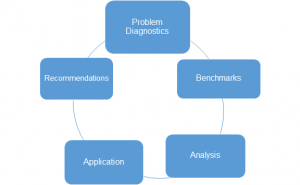INTJs are best suited to become remarkable entrepreneurs because of their ability to discover patterns in the marketplace where new and innovative products and services can be developed for specific audiences. The innovative hardwiring of INTJs allows them to potentially revolutionize industries through their systematic and organized ways of creating groundbreaking products and services.
Hayes (2020) of Investopedia defined an Entrepreneur as “An individual who creates a new business, bearing most of the risks and enjoying most of the rewards. The entrepreneur is commonly seen as an innovator, a source of new ideas, goods, services, and business/or procedures…
Entrepreneurs play a vital role in any economy, using the skills and initiative necessary to anticipate needs and bring good new ideas to market.”
The core personality of INTJs is suited for creating business enterprises where they are in control and in charge.
Personality Growth (2019) suggested that: INTJs are very independent people, and because of this, they don’t really like answering to anyone else. Often, working under people can be frustrating for the INTJ, leaving them feeling drained and uneasy with their job. When they choose to be their boss, the INTJ often feels mightily rewarded by this option. They enjoy the space and freedom to make their own choices and not have to constantly answer to someone else’s expectations constantly.
INTJs are natural problem solvers and can often find ways of getting things done even when something gets in the way (para. 5).
In a complex marketplace, the ability to spot trends and create products and services that solve problems makes INTJ entrepreneurs more necessary than ever.
Generally, INTJs are pattern-seeking individuals who have the makings of remarkable entrepreneurs.
The Personality Club (n.d.) postulated that: INTJs often see things that other people don’t or can’t. This is because of their dominant function, introverted intuition. This function is constantly sifting through all the information that it gathers and finding patterns (para. 1).
Unfortunately, the innovative aspect of entrepreneurialism is often lost with the flippant use of the term. The critical element of Hayes’ definition is that entrepreneurs bring new and innovative ideas to the marketplace. This is the crucial difference between mere business ownership and franchising. Entrepreneurs view opportunities with fresh eyes that others often don’t see.
Traditional business people enter saturated markets participating in commodifying goods and services. In other words, there is nothing new or innovative that they bring to the market. Socks are socks. And soap powder is soap powder.
Contrarily, entrepreneurs, particularly INTJs, reimagine what socks or soap powder can be and relentlessly pursue new ways of presenting these new products to the market and new uses.
INTJs who opt to become entrepreneurs remain committed to their hardwiring by not replicating the actions and behavior of extroverted entrepreneurs.
Miller (n.d.) said: An introvert should not be following an extrovert’s roadmap to building a business. They need to follow a different path to success – an approach rarely talked about because introverts aren’t doing the talking…Extroverts sell with persuasion. Introverts sell with information.
Miller’s proclamation aligns with the intellectual understanding of INTJs. The internet allows entrepreneurial INTJs to create software and intellectual property within silos. Gone are the days when entrepreneurial INTJs have to adopt the mannerisms of extroverts.
Now, INTJ entrepreneurs can dissect a problem, discover benchmarks, analyze possible solutions, and present recommendations. All behind a computer within the confines of their homes.
Moreover, INTJs’ natural inclination towards reading, writing, and solitude makes them the perfect purveyors of new online products and services.
What are the components of the IBAR process?
There are numerous strategic and critical thinking methods INTJs can use to formulate a plan for their entrepreneurial pursuits.
The IBAR Critical Thinking Method (IBAR) is a simple, fast, and concise way of moving a problem from diagnostics to solution-based recommendations.
IBAR is an acronym for Issue, Benchmarks, Analysis/Application, and Recommendations.
It is a critical thinking method inspired by similar methods used in many American law schools and leading business schools but geared for the average person.

Issue (Problem Diagnostics): The issue or problem begins the process. All products and services are designed to solve a problem in the marketplace. The Issue part of IBAR answers the problem’s What, When, Why, Where, and How.
By diagnosing the issue correctly, you begin asking the right questions for developing solutions that lead to creating new and innovative products and services.
You want to know the problem to isolate its impact on the marketplace for specific audiences.
By understanding when the issue occurred, you can determine a timeline that allows you to ascertain what happened at that time that might have created the issue. By keeping a timeline of events, you can better determine what period may need to be focused on to resolve the issue’s life cycle.
Determining why an issue exists may require as many possibilities as there are solutions. Therefore, including what can be drawn from facts and what assumptions might need to be made.
Finally, how the issue occurred may or may not be immediately known. But, by combining all the possible angles to an issue (What, When, Why, Where, and How), you have done a thorough diagnostic of the issue’s totality, giving you direction and insight into what is to be considered.
It’s acceptable to have repetition in diagnosing a problem to ensure all the possibilities have been exhausted. Otherwise, you will miss something in your diagnosis that can impact your benchmarking and analysis.
Benchmarks: Benchmarking is a method of comparing your business, ideas, and models against industry standards, leaders, or best practices. When a problem arises, you can gauge the options available for resolution.
With the advent of the internet, benchmarking is easily accessible once you understand the primary research methodologies afforded for generating best practices within other industries transferable to your own.
Once you have isolated possible solutions to your problem, you can begin analyzing and developing applications.
In his book, “The Art of What Works,” Dr. William Duggan suggested that it will work again by reviewing what has worked successfully in the past, with some tweaking. Good examples are remakes of past successful songs, movies, and fashion.
If they were hits in the past, they likely would be hits now. By developing case studies of best practices, precedents, and standards that succeeded, you are, as William Shakespeare attributed to his success, “Making new words out of old words.”
Becoming well versed in multi-disciplines will make connecting seemingly disconnected ideas and concepts easier. In this vein, innovative solutions aren’t derived from wishful thinking. Creative solutions come from past successes modified for current needs and usage.
For example, if you determine that your issue is creating attractive technology that makes a cult following, you would benchmark Apple, IBM, and Facebook for starters. How would you choose your benchmarks?
You might put in the search engine “Most innovative companies in the 21st century.” When you do a Google search of this inquiry, an article titled “2019: World Most Innovative Companies.” The article breaks down companies by industries.
By researching how these companies innovate, you can discover how to use these benchmarks to make your company more innovative. The most important aspect of critical thinking is the ability to use external information and facts to solve problems and understand the social phenomenon.
Analysis/Application: The ability to decipher, filter, and connect disparate information comprehensively is essential for solving your audience’s problem. Any solution-based analysis has to be grounded in practical applications.
After you have determined the relevance of the best practices you have benchmarked, you have to ensure that the benchmarks fit into your operations. The critical thinking process is essential during IBAR’s Analysis/Application section.
The ability to compare, contrast, and weigh the benefits and liabilities is deliberated here to determine your recommendations.
Analyses ask two questions: How does a benchmark work? And why does a benchmark work? In this analysis, you want to explore the benefits and liabilities of benchmark usage. Knowing how a benchmark works helps you see a better way of solving your problem.
Many people look at an industry leader’s standing and attempt to duplicate it without analyzing how and why it works, which will work in your situation. It is a way of solving your problem and effectively using a proven formula for professional success. In conjunction, knowing why it works helps illuminate its effect on your business.
Do not rush to judgment without thoroughly vetting the benefits and liabilities. There is always a downside to every upside, so be vigilant in your analysis. If you are a corporate training company and want to use SkillPath Seminars as a benchmark, do you have the personnel that nets over $10 million a year?
You can still use SkillPath as a benchmark, but you may have to offer fewer seminars and fare better with a smaller team.
Recommendations: Unlike legal analysis, which calls for a conclusion, the IBAR critical thinking analysis calls for recommendations. Because of the mutability and flux of the business environment, recommendations allow for innovation and creativity based on the current landscape.
The overarching value of critical thinking is the flexibility and agility of trained minds in looking at problems and understanding the process of developing viable solutions based on practical research.
Providing recommendations allows you to change and tweak your solutions as the situation requires. You may triage or rank by priority the recommendations for your solution. You may engage in small experiments that allow you to determine which solutions are most effective for turning around a problem.
However, if you have a solution that benefits outweigh liabilities and fit into your operations, go with that one. The keys to successful implementation are to remain open-minded, flexible, and objective. Let facts and data lead you to your decisions.
In a global economy, the opportunity to become an entrepreneur has never been more available. INTJs who follow this path can do good and do well simultaneously.
To be born predisposed for great success is INTJs’ birthright. To live any other way is sacrilegious.
—Edward S. Brown, M.S.
Related: The IBAR Way of Critical Thinking & Thought Leadership

References
Brown, E. (2016). The IBAR way of critical thinking & thought leadership. Atlanta, GA: Core Edge Image & Charisma Institute, Inc.
Hayes, A. (2020, July 1). Entrepreneur. Investopedia. Retrieved from: https://bit.ly/3ORPVl4.
Miller, M.T. (n.d.), Entrepreneurship for INTJs. MTM. Retrieved from: https://mtm.dev/intj.
Personality Growth (2019, Sept. 19). INTJs entrepreneurs: The pros and cons of being an INTJ entrepreneur. Elite Café Media Lifestyle. Retrieved from: https://bit.ly/3zmmF0b.
The INTJ as an entrepreneur (n.d.). Personality Club. Retrieved from: https://bit.ly/3PNEtsc.




